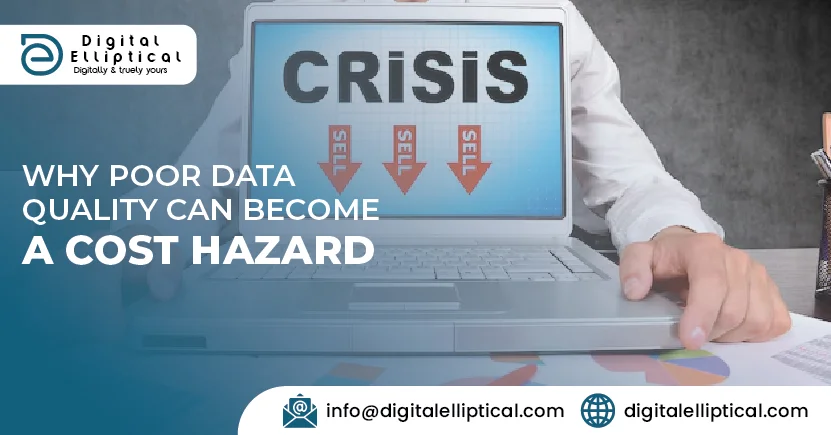Why poor data quality can become a cost hazard
As data becomes the new engine for global business, data quality becomes increasingly important. There is no doubt that raw data is valuable; but, a system is required to refine and sustain its quality.
Poor data quality can have a substantial impact on enterprises, organizations, and individuals alike. Inaccurate, incomplete, or inconsistent data can result in poor decision-making, operational inefficiencies, and damaged consumer experiences. The cost of poor data quality extends beyond financial losses, including reputational harm, missed opportunities, and regulatory violations.
There are numerous approaches to determine the value. Forbes reports that organizations with poor data quality can lose up to $3.1 trillion in the US alone, or 20% of their value. But the million-dollar question is, why does poor data quality cost so much money?
Poor data quality wastes everyone’s time
Unmanaged data wastes a lot of time in every department, including data scientists, engineers, and salesmen. According to Gartner, poor data quality reduces labor productivity by up to 20%.
The diagram above displays the average difference between each role after implementing a sophisticated data quality automation solution. So, one of the most typical issues that businesses have is that after their data sets are created, they are recopied and distributed to other interconnected teams. As a result, one of the most significant challenges for any data-driven company is getting the appropriate data to the right people at the right time.
Organizations can use data quality automation to work on data that is ready to use when it arrives. Decision-makers can make everyday decisions without waiting for their facts to become validated and actionable.
Poor data quality leads to poor analytics
Poor data quality is a primary obstacle to effective and accurate analytics. The phrase "garbage in, garbage out" is often used to describe the direct impact of poor data quality on analytical outcomes. Here's how poor data quality leads to poor analytics:
- Inaccurate Insights: If the data used for analytics is inaccurate, incomplete, or outdated, the insights generated from the analysis will be equally flawed. Incorrect data can lead to erroneous conclusions and misinformed decisions.
- Bias and Misrepresentation: Poor data quality can introduce biases into the analysis, skewing the results and leading to misrepresentations of the actual situation. Biased data can perpetuate unfair or discriminatory outcomes, affecting various aspects of an organization's operations.
- Unreliable Predictions: Predictive analytics heavily relies on historical data to forecast future trends and outcomes. If historical data is of poor quality, the predictive models will be less reliable and may fail to accurately forecast future events.
- Inconsistent Reports: When data quality is inconsistent, it becomes challenging to create standardized and reliable reports. Decision-makers might receive conflicting reports from different sources, making it difficult to draw meaningful conclusions.
- Increased Uncertainty: Poor data quality introduces uncertainty and doubt into the decision-making process. Stakeholders may lose confidence in the analytics and become hesitant to base critical decisions on the insights derived from the data.
- Wasted Resources: Data analytics requires time, effort, and resources. If the data used for analysis is of poor quality, all the resources invested in the analytics process may go to waste, yielding minimal value or potentially misleading results
- Poor Data Visualization: Data visualization is a powerful tool for presenting complex information in a digestible manner. However, poor data quality can lead to misleading visualizations that convey inaccurate information, hindering effective communication.
Poor data quality ruins customer experience
Poor data quality can certainly degrade the consumer experience. Customer experience is an important aspect in the success of any business, and data can help you analyze, personalize, and improve that experience. When data quality is compromised, it can have various negative consequences for the consumer experience.
Inaccurate Personalization: Data quality concerns can result in erroneous client profiles and preferences. As a result, businesses may struggle to create individualized experiences, resulting in irrelevant recommendations and offers that do not appeal to clients.
Misguided Customer Communication: Poor data quality might lead to erroneous contact information or communication choices. This can result in customers receiving irrelevant or untimely messages, generating aggravation and possibly driving them away.
Inaccurate Personalization: In customer service interactions, accurate and up-to-date data is essential for efficient issue resolution and personalized support. When agents have incomplete or incorrect customer information, it can lead to longer resolution times and unsatisfactory customer service experiences.
Lost Trust and Credibility: When customers encounter errors in their interactions with a company, it erodes their trust and confidence in the brand. Repeated instances of poor data quality can lead customers to question the organization's reliability and credibility.
Missed Opportunities to Delight Customers: Accurate data enables businesses to identify opportunities to surprise and delight customers. However, poor data quality may prevent businesses from recognizing such moments and providing exceptional experiences.
Impact on Customer Loyalty and Retention: A negative customer experience resulting from poor data quality can lead to customer churn. Dissatisfied customers are more likely to seek alternatives and switch to competitors who can better meet their needs.
Reputation Damage: Poor data quality issues can become public, especially in cases of data breaches or improper data handling. Such incidents can severely damage a company's reputation and brand image, deterring potential.
Don’t lose valuable resources, time, and money
Finally, poor data quality results in lost money, missed opportunities, and inaccurate situational analysis. To avoid all of this, companies must emphasize data quality management and engage in data quality initiatives as soon as possible.
Investing in strategies to streamline data collecting and processing can yield significant returns. When your data is fully automated and appropriately processed, companies can find the right path and acquire momentum through increased revenue sources.
Start with DIGITAL ELLIPTICAL - Keep your data clean :
Organizations want high-quality data to function optimally; this will assist them in staying informed, increasing efficiency, and maximizing overall revenue.





